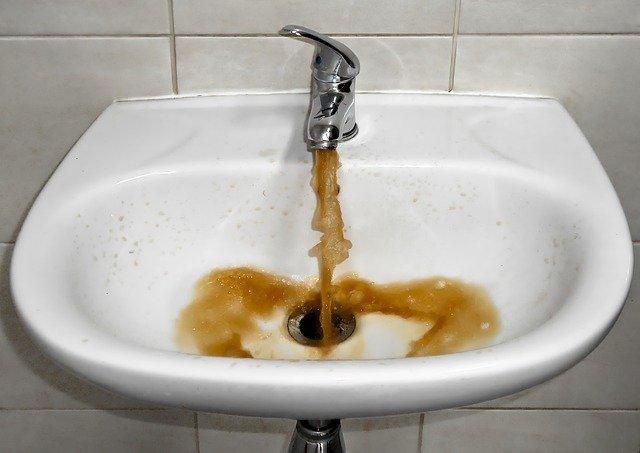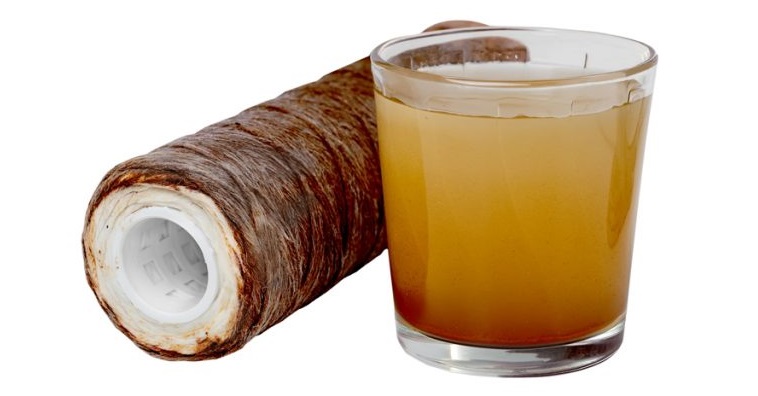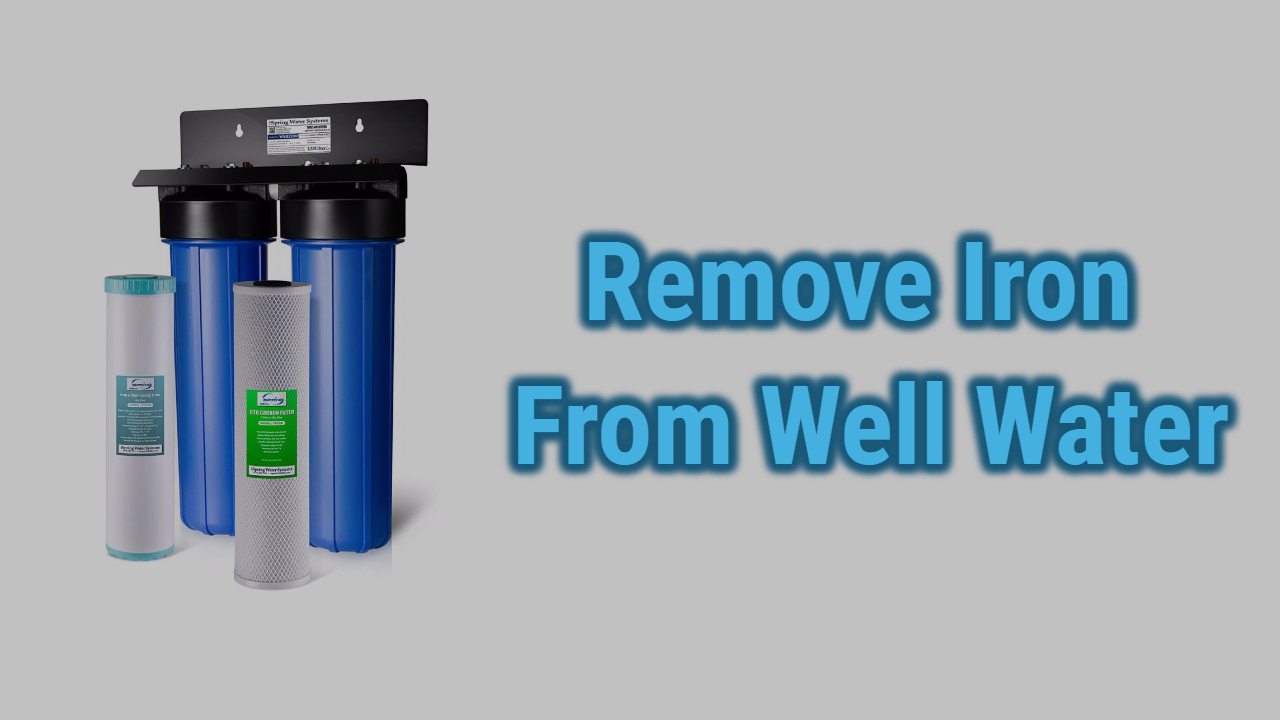The iron in the water can be a very frustrating problem. It can leave very ugly stains and rust on your sink and bathtub. The worst thing about it is that it does not even come off easily from the surface. Although iron is one of the most common contaminants that is found in the water, it is known to be the reason that makes the water hard.
The iron can also cause a metallic taste or smell in the water. Extra iron in your water can cause abdominal issues and body aches. Iron, if consumed in larger quantities, can be toxic for your health. If you are using well water, there are chances of a high amount of iron in it.
We have prepared this article to answer your questions about the following things,
- What is iron?
- How does iron get into the water?
- The problems caused by iron in the water.
- Different types of iron in the water.
- How to remove iron from the well water?
Iron, manganese, and sulfur are found in the well water, but the amount that you find in the water differs according to the areas. The iron that creates rust on your bathroom floor, imagine what amount of iron will do to your body.
Table of Contents
What is iron?
Iron is one of the metals that is found naturally on the surface or inside the earth. When the snow or rain on the surface of the earth seeps inside, the substances of iron also get collected in the water. and after that, it is in the water that you get from the well.
Sometimes the water lines also have the corrosion of iron in them. You must have noticed how iron gets rusted when it comes in contact with water and oxygen. Iron makes up 5 % of the earth’s crust, so it is obvious that part of them will get inside the well water.
How does the iron get into the water?
Your well water basically comes from the reservoir of the earth, and this water consists of snow melts and rain. All that water that seeps in through the surface to the earth’s reservoir or well. The water lines that are made from different metals also face natural corrosion, and that also leaks in the water. When you use this well water, you will be using the same water iron contained water for regular purposes. That is not good for your health at all.
Iron contained water is also defined as hard water, and the hard water contains other minerals like calcium, magnesium, and manganese. Hard water can have an extremely bad effect on your health and your skin. That is why it is necessary that iron is removed from the water. You must be wondering how you get to know if there is iron in your well water.
Here are a few things you can notice or test if you have iron in your water.
- The water will have some kind of color in it. Mostly the water with iron in it seems yellow-ish or red-ish. If there is an extremely high amount of iron in the water, it might even seem to be brown as well.
- You can even check the amount of iron in your water by getting the water tested in a laboratory.
- The water will have a metallic taste to it, and more than that, it will also affect the taste of the food you cook with it.
- Your tea or coffee will have an extremely black color if there is iron in the water that you use. It will also taste different than your regular coffee.
- Your bathroom floor, bathtub, sinks, or faucets will have red or brown stains on them, which will be really hard for you to wash off.
- The high amount of iron in the water will clog your skin and cause severe acne breakouts or other skin problems.
- The iron, when mixed with other contaminants and metals, causes scaling in the plumbing lines. The scaling even becomes worse with water and oxygen. In the long term, this scaling can block the waterline and slow your water flow.
Let us tell you about the hazardous effects iron has on your appliances, children, and your overall health.
Problems caused by iron in the water

If you are wondering what are the problems iron causes, this part of the article might help you get the idea about the issues and health problems caused by iron.
- Iron is highly hazardous to your health. Even though it is one of the most important contaminants that the human body needs to transport the oxygen in the blood, the increased amount of iron consumed can harm your skin and body inside and out.
- Iron changes the taste of the food. Sometimes you will not be able to recognize the difference in the taste, but you will be consuming it. So if you somehow notice even a slight change in the taste of food, there is iron in your water.
- How can we forget the stubborn stain that iron causes near water outlets? and let us tell you that these stains don’t even go away that easily. If you have iron in your water, you can say goodbye to a clean, spotless bathroom floor and tub.
- The iron in the water mixes with other toxins and forms harmful bacterias. These harmful iron bacteria can be clogged in your pipelines and make the water coming out of your shower more contagious.
There are many more issues that are caused by iron in the water, and it is advised to remove the iron from the water.
If your well water has the amount of iron at 0.3 milligrams per liter, you do not need to worry. But if it is more than that, you need an iron removal system.
Different types of iron in the water

Even if iron is not considered a contaminant, it is still a metal and can be harmful to your health. There are different types of iron that are found in the water. There are different ways to remove each type of iron from the water, but before we look into ways to remove iron from the water. Let us learn about the types of iron you can find in your well water.
Ferrous iron
Ferrous iron is the kind of iron that is dissolved into the water. This type of iron is also known as clear water iron because you cannot see it in a glass full of water. Ferrous iron makes your laundry come out dull and leaves yellow stains on the tiles. If you want to find out at home if there’s ferrous iron in your water, just pour the water on a white tile surface and let it dry. If there is ferrous iron in the water, there will be a yellow or red stain on the place where the water was.
Ferric iron
This kind of iron in the water is practically iron dust, and you can easily spot it floating in the water. It is even called red water iron. If there is ferric iron in your well water, you will notice that the water will also seem cloudy. This type of iron causes red stains or rust on the surfaces. Ferric iron is the most hazardous type of iron that you can find in your well water.
Organic iron
Organic iron is the type of iron that is naturally found in well water. The worst part about this type of iron is that it mixes up with other minerals and makes the water taste even worse. There is no big issue about health with this kind of iron, but it is necessary to make sure about what kind of other minerals are there in your water.
How to remove iron from the water?

Different kinds of iron need different kinds of methods and systems to remove iron from the water. We have prepared a list of ways you can choose to remove iron from the water. It is necessary that you figure out what kind of iron is there in your well water so that whatever you do to remove the iron from the water.
1. Sediment filters
A sediment filter removes ferric iron from the well water. Although sediment filters also remove large particles from going further, they do not even affect your water flow. It prevents dust, rust, etc. You have to check the micron rating of the filter cartridge first. If the sediment is made out of large microns, there is a low probability of iron being removed from the water. Make sure that you do not get any random sediment filter for the removal of iron. If the sediment filter is of small microns, it can remove ferric and ferrous iron from the water but just to make sure that it happens, choose a sediment filter that is specially made for iron removal.
2. Water softeners
Any standard water softeners follow an ion exchange process that oxidizes sediments, iron, and manganese from the water. This oxidization process positively charges iron in the water as well as other components like it. When the iron is oxidized, it will attach itself to the resin beads in the softener. You do not have to worry about the iron being attached to the resin beads of the system forever because almost all the softeners follow a regeneration process that sends the collected iron and manganese down the drain.
Water softeners mostly remove the ferrous iron from the well water. Also, you have to flush the iron removal softener regularly.
3. Manganese Greensand
Greensand is one of the most effective ways to remove iron from well water. When iron or manganese is oxidized with greensand, they turn into a solid form. This solid-formed iron is then separated from the water and attaches itself to the greensand media. If there is a high amount of ferric iron in your well water, Manganese greensand is one of the best ways to remove that. One thing to keep in mind if you want to use greensand for removing iron from the water is that you will have to backwash the greensand periodically. For the back-wash process, you will need to wash it out with potassium permanganate. It will remove all the iron that is collected and attached to the greensand.
4. Birm
Birm is specifically used to remove dissolved iron and manganese from the water. Birm is also one kind of oxygenating media. It works only with water that has a high level of pH. You do not need any other media to help birm in this process, but birm combines with calcite, which is responsible for elevated pH levels of the water, and the combination of these two makes the iron and manganese removal more effective. Birm is more effective for the ferrous iron in your well water.
5. Iron filter
The iron filter has to be one of the most effective ways to remove the iron from the water. If we were to put up straight facts in front of you, then it is necessary to tell you that water softeners work the best if you have the iron filter installed before it. If there is an extremely high amount of iron in the water, only getting a water softener will not work. Almost all the iron filters will require backwashing depending upon the amount of iron in the water. Iron filters work like sediment filters, and they stop the iron particles in the water from going forward. The only thing you will need to make sure to find out is how many gallons you will need to regenerate the filter.
6. Oxidization
If there is a high amount of dissolved iron in your well water, you might need to look for a system that only focuses on oxidization. You can use substances like aeration, chlorine, hydrogen peroxide, ozone, and potassium permanganate. With these substances, all of the dissolved iron will be oxidized and will be turned into ferric iron. Depending upon the amount of dissolved iron in the water, you can choose the specific substance-based system.
7. Chemical feed plumping
Sometimes well water has an extremely high amount of iron that no filters or softeners can remove. At that time, you have to use a chemical pump. Certain chemicals are added directly into the well to prevent the iron from coming up in your water line. You need to be careful about the chemical you choose to put in the water. Now, this kind of chemical pumping needs professional advice. If you don’t take particular care in choosing a chemical for the process of feed plumping, it might be problematic for you. The chemical you can use for feed plumping can be from any of the chemicals mentioned below,
- Chlorine
- Hydrogen peroxide
- Sodium carbonate and many few others
Conclusion
In conclusion, we have learned that the first important stage is to find out the amount of iron in your well water. If you do not know how much iron is there in the water, finding the right way to remove it from the water will be a hard task. Because the iron originally comes from the earth, there will always be some amount of it in the well water. You can get the water report done to find out the amount of iron in the water, or if there is an extensive amount of iron, you might be able to spot it.
If you choose an iron removal system, then iron filters, softeners, and oxidation are the most effective ways to remove iron from the water. Before you choose a filter system to remove iron from the well water, make sure you do thorough research or hire a professional for it.
We hope this article will help you shed light on some of the issues and solutions related to the iron in your well water.
